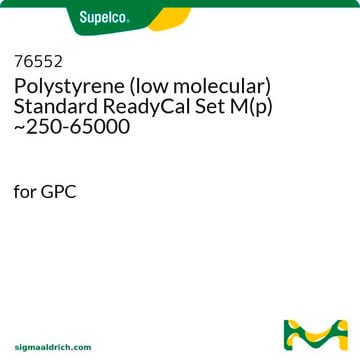92264
4-Methoxyphenol
analytical standard
Sinonimo/i:
4-Hydroxyanisole, 4-MP, HQMME, Hydroquinone monomethyl ether, MEHQ, p-Guaiacol
Scegli un formato
Scegli un formato
About This Item
Prodotti consigliati
Grado
analytical standard
Livello qualitativo
Densità del vapore
4.3 (vs air)
Tensione di vapore
<0.01 mmHg ( 20 °C)
Saggio
≥98.5% (GC)
Temp. autoaccensione
789 °F
Durata
limited shelf life, expiry date on the label
tecniche
HPLC: suitable
gas chromatography (GC): suitable
Impurezze
≤0.5% water
P. ebollizione
243 °C (lit.)
Punto di fusione
55-57 °C (lit.)
applicazioni
cleaning products
cosmetics
environmental
flavors and fragrances
food and beverages
personal care
Formato
neat
Stringa SMILE
COc1ccc(O)cc1
InChI
1S/C7H8O2/c1-9-7-4-2-6(8)3-5-7/h2-5,8H,1H3
NWVVVBRKAWDGAB-UHFFFAOYSA-N
Informazioni sul gene
human ... TYR(7299)
Cerchi prodotti simili? Visita Guida al confronto tra prodotti
Categorie correlate
Descrizione generale
Applicazioni
Avvertenze
Warning
Indicazioni di pericolo
Consigli di prudenza
Classi di pericolo
Acute Tox. 4 Oral - Aquatic Chronic 3 - Eye Irrit. 2 - Skin Sens. 1
Codice della classe di stoccaggio
11 - Combustible Solids
Classe di pericolosità dell'acqua (WGK)
WGK 1
Punto d’infiammabilità (°F)
Not applicable
Punto d’infiammabilità (°C)
Not applicable
Scegli una delle versioni più recenti:
Possiedi già questo prodotto?
I documenti relativi ai prodotti acquistati recentemente sono disponibili nell’Archivio dei documenti.
I clienti hanno visto anche
Filtri attivi
Il team dei nostri ricercatori vanta grande esperienza in tutte le aree della ricerca quali Life Science, scienza dei materiali, sintesi chimica, cromatografia, discipline analitiche, ecc..
Contatta l'Assistenza Tecnica.











